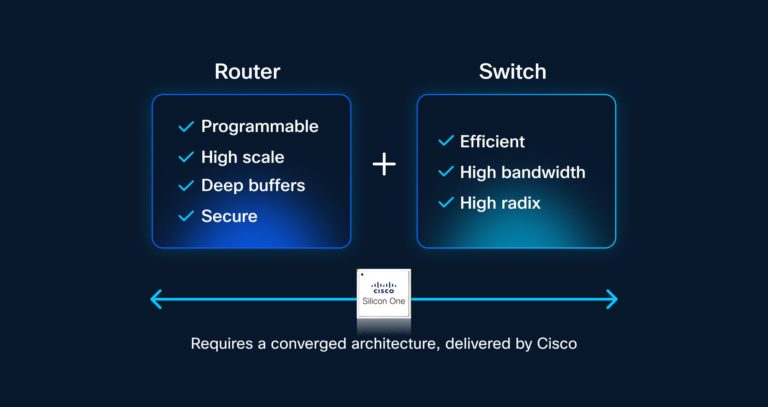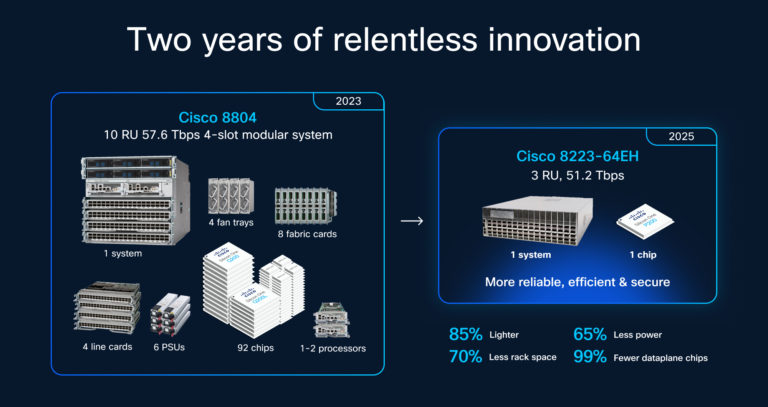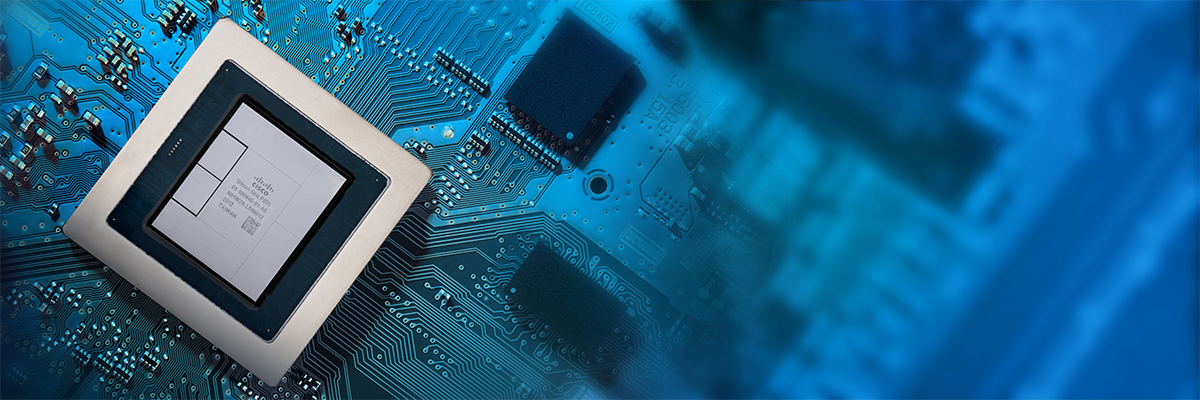Cisco Silicon One P200 Powers the First 51.2T Scale-Across Routing Systems
作者:Rakesh Chopra,
Cisco Silicon One uniquely stands as the industry’s most scalable and programmable unified networking architecture, purpose-built to address the evolving requirements of modern networks. It has reached a pivotal milestone—gaining strong market traction and supporting a diverse range of networking needs through multiple specialized product series. Its innovative, secure, scalable, and programmable design enables the creation of dedicated product families tailored for virtually any deployment scenario.
The remarkable growth in scaling of artificial intelligence (AI) training clusters of GPUs over the past six years, from hundreds to hundreds of thousands, has been instrumental in advancing AI. However, this exponential growth has made power consumption the primary limiting factor. Traditional AI workload expansion through “scale-up” and “scale-out” methodologies is proving insufficient.
The great migration of data centers
Massive data centers consume vast real estate and prodigious amounts of energy. This ongoing expansion has led to the “great migration of data centers” to less-populated areas with cheaper electricity. This dynamic, while addressing land and power costs, necessitates extensive data backhauling to consumers, significantly escalating WAN traffic.
While this migration helps alleviate the challenges of new facility construction and local power availability, it does not inherently solve the critical need to scale AI clusters beyond the confines of a single site. Instead, to mitigate rising power constraints, AI workloads must be distributed across data centers in multiple locations.
To address this explosive growth, secure, reliable, and efficient “scale-across” deployments are essential. This advanced strategy involves seamlessly extending AI workloads across broad geographical regions, thereby optimizing resource utilization and ensuring the sustained growth necessary for future breakthroughs.
Meeting this demand requires high-scale, secure deep-buffer routers that match the bandwidth and power efficiency of switching silicon. Routing and switching functions must converge into a unified solution, which Cisco Silicon One delivers. Data centers that fail to address these evolving AI traffic trends face significant performance risks, including capacity bottlenecks that could hinder AI processing and growth.
Moreover, neglecting the need for fully programmable, run-to-completion engines risks costly and disruptive future network upgrades to support emerging protocols and standards. Therefore, proactive planning and provisioning of backbone networks today are critical to ensuring the robust network performance of tomorrow.
There are two certainties in the world of network:
- Malicious users will target infrastructure
- At scale, network failures are inevitable
A single security breach can undermine trust in AI systems–and even minor packet loss can seriously disrupt AI jobs, wasting time and resources.
Therefore, we need:
- End-to-end security. Beyond encryption, we need comprehensive hardware-based protections across the full product lifecycle.
- Deep buffering. Even with advanced proactive congestion control to minimize buffer build-up, deep buffers are necessary to absorb dynamic traffic shifts during outages.
Introducing the secure scale-across solution: Cisco 8223 with Silicon One P200
With the launch today of the Cisco 8223—powered by Cisco Silicon One P200—Cisco is laying the foundation for the great migration of data with the first routing system of its kind: delivering 51.2 Tbps capacity, unprecedented power efficiency, security, and reliability—all at switching bandwidth.
Showcasing Cisco’s rapid innovation and leadership in AI networking, Cisco 8223 systems are now shipping to initial hyperscalers, setting the stage for the scale-across era. This milestone highlights our commitment to delivering advanced solutions that meet the evolving demands of large-scale AI infrastructure.
Five reasons Cisco is setting the scale-across industry standard
1) Unmatched performance and scalability
Powered by the P200, the Cisco 8223 offers industry-leading routing performance, processing over 20 billion packets per second and over 430 billion lookups per second. The Cisco 8223 seamlessly integrates into existing infrastructure or serves as the foundation for new deployments. Its fixed form factor design offers reliability, simplicity, and ease of scaling, whether enhancing current capabilities or building out new distributed AI clusters.
Leveraging the P200’s full 512 radix, it can scale to 13 petabits using a two-layer topology, or up to a massive 3 exabits using a three-layer topology, providing unparalleled performance for routing applications and ensuring seamless, high-speed data delivery.
The Cisco 8223 supports a variety of network operating systems (NOS) including open-source options such as SONiC with planned support for IOS XR. Additionally, Cisco Nexus 9000 Series Switches, powered by Cisco Silicon One P200, will offer support for NX-OS.
2) Routing capabilities with switching bandwidth and efficiency
By leveraging Cisco Silicon One’s converged architecture, the Cisco 8223 stands out as the industry’s only 51.2 Tbps deep-buffer router featuring a fully shared packet buffer. This unparalleled capacity and intelligent buffering are specifically designed to absorb massive traffic surges from AI training load sharing, ensuring consistent performance and mitigating network congestion. It simultaneously optimizes power efficiency because its fully shared packet buffer design inherently eliminates unnecessary packet data movement within the device, delivering industry-leading routing bandwidth and efficiency.

3) Industry-leading power efficiency
Power—not compute or network capacity—has emerged as the primary constraint in scaling AI to unlock new levels of intelligence. The amount of power that can be delivered to a single site, along with the high cost of power in densely populated regions where most network bandwidth is consumed, now limits the scalability of AI systems.
Cisco has been in the pursuit of relentless innovation over the last two years. With one system powered by one chip, the Cisco 8223 3 RU, 51.2 Tbps configuration consumes about 65% less power than prior generations.

As the only fixed silicon architecture-based router available today, the Cisco 8223 architectural design—with P200 at the heart—achieves significantly lower power consumption compared to alternatives, directly addressing hyperscalers’ demands for environmentally friendly and cost-effective networks.
4) Groundbreaking smart adaptive processing
Cisco Silicon One’s advanced, custom-built, real-time adaptive run-to-completion engine intelligently conserves power during AI workloads while enabling advanced processing at full line rate. This unique architecture makes it the only processor of its kind.
Unlike other programmable processors that rely on rigid programmable pipelines—often resorting to ad hoc exception paths for extended processing, or even packet recycling that inherently halves effective bandwidth—our future-proof design natively supports emerging and yet unknown protocols and standards. This eliminates the need for costly hardware upgrades and makes the processor ideal for the demands of scale-across deployments.
Its advanced programmability ensures your network seamlessly adapts as AI traffic evolves—preventing performance bottlenecks, accelerating feature innovation, and providing unparalleled, real-time observability for proactive management and rapid troubleshooting.
5) Uncompromising security, engineered from the ground up
Designed with security and observability capabilities at its core, Cisco Silicon One protects hardware, software, and networks from attack throughout the entire lifecycle. Users benefit from advanced capabilities like line-rate encryption, an integrated tamper-resistant root of trust, and a built-in authentication engine. These features work in concert to safeguard your network, system, and forwarding code and tables against the most sophisticated emerging threats across the full product life cycle.
Key security differentiators include:
- Line-rate, high-scale encryption: Supports MACsec, IPsec, ClearTag, and CloudSec for comprehensive hop-by-hop and end-to-end data protection and post-quantum resilience.
- Integrated, tamper-resistant root of trust: Establishes a secure foundation for system integrity.
- Authenticated data plane software and configuration: Ensures only trusted code and settings are executed.
- Built-in hardware analyzers: Provides nanosecond-level traceability, exportable with programmable in-band telemetry for deep visibility and rapid threat detection.
These features empower data centers to handle explosive AI data traffic growth sustainably and securely, with solutions already shipping and deployed in customer labs.
Ultimate deployment flexibility
With the most versatile deployment options in the industry, the P200 is the only 51.2 Tbps routing silicon deployable in fixed systems, modular platforms, and disaggregated chassis, offering ultimate architectural flexibility. This consistency simplifies network design, deployment, and maintenance across all traffic volumes.
- Power-efficient systems powered by the industry’s first standalone 51.2 Tbps routing chip: Available in fixed or centralized forms, the P200 offers superior power efficiency and performance. A single P200-based system handles the traffic that previously required six 25.6 Tbps fixed systems or a four-slot modular system, with significantly less power.
- The industry’s largest two-tier and three-tier Ethernet routing networks: Composed of deep-buffer, fixed leaf systems, the P200 is the optimal solution for massive traffic backbones—delivering leading scalability, power efficiency, and any-to-any port connectivity essential for high-capacity AI load sharing network deployments.
- The industry’s largest modular systems: P200-based systems deliver over 500 Tbps capacity within a fully scheduled, non-blocking fabric, enabling comprehensive any-to-any port connectivity.
This comprehensive coverage ensures that all data center networks can refresh their backbone plans to support AI traffic growth effectively.
The future of AI networking is here
Cisco Silicon One portfolio is continuously growing, evolving, and transforming to meet the expanding needs of the AI era. By unifying routing and switching, providing real-time adaptable programmability, and integrating robust security, Cisco Silicon One ensures reliable, future-ready networking growth and efficiency to scale up, scale out, and now scale across.
With the Cisco 8223 powered by the Cisco Silicon One P200, organizations can confidently architect their distributed AI environments to scale across with 51.2 Tbps performance, deep buffers, advanced security, and flexible OS options. The Cisco 8223 stands out as the router of choice for scalable and cost-effective AI innovation.
Learn more about how the Cisco 8223 router makes it possible to “scale across”
multiple data centers for high-performance AI networking.
Additional Resources:
关于《Cisco Silicon One P200 Powers the First 51.2T Scale-Across Routing Systems》的评论
暂无评论
